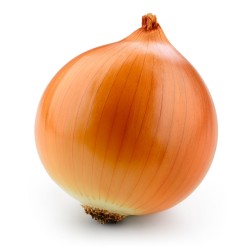Menu
-
MenuBack
- Home
-
Categories
-
-
Categories
-
Vegetable Seeds
-
Varieties by Country
- Varieties from Armenia
- Varieties from BiH
- Varieties from Croatia
- Varieties from France
- Varieties from Germany
- Varieties from Greece
- Varieties from Hungary
- Varieties from India
- Varieties from Italy
- Varieties from Japan
- Varieties from North Macedonia
- Varieties from Peru
- Varieties from Russia
- Varieties from Serbia
- Varieties from Slovenia
- Varieties from Spain
- Varieties from Thailand
- Varieties from Turkey
- Varieties from USA
- Tomato Seeds
- Corn Seeds
- Gourd family
- Bean family
- Cucumber Seeds
- Pepper Seeds
- Carrot family
- Onion family
- Lettuce Seeds
- Potato family
- Cabbage family
- Radish Seeds
- Beetroot family
- Watermelon Seeds
- Melon Seeds
- Cauliflower Seeds
- Sunflower family
-
Varieties by Country
- Fruit Seeds
- Chili - Habanero Seeds
- Medicinal Herb Seeds
- Climbing Plants Seeds
- Trees Bonsai Seeds
- Palm Seeds
- Ornamental Grasses Seeds
- Tobacco Seeds
-
Vegetable Seeds
-
-
-
-
- NEW PRODUCTS
- Create account
- Delivery - Payment
- FAQ
- Home
-
- Large Packets of Seeds
- Giant Plants Seeds
- Vegetable Seeds
- Varieties by Country
- Varieties from Armenia
- Varieties from BiH
- Varieties from Croatia
- Varieties from France
- Varieties from Germany
- Varieties from Greece
- Varieties from Hungary
- Varieties from India
- Varieties from Italy
- Varieties from Japan
- Varieties from North Macedonia
- Varieties from Peru
- Varieties from Russia
- Varieties from Serbia
- Varieties from Slovenia
- Varieties from Spain
- Varieties from Thailand
- Varieties from Turkey
- Varieties from USA
- Tomato Seeds
- Corn Seeds
- Gourd family
- Bean family
- Cucumber Seeds
- Pepper Seeds
- Carrot family
- Onion family
- Lettuce Seeds
- Potato family
- Cabbage family
- Radish Seeds
- Beetroot family
- Watermelon Seeds
- Melon Seeds
- Cauliflower Seeds
- Sunflower family
- Varieties by Country
- Fruit Seeds
- Chili - Habanero Seeds
- Medicinal Herb Seeds
- Climbing Plants Seeds
- Trees Bonsai Seeds
- Banana Seeds
- Palm Seeds
- Ornamental Grasses Seeds
- Tobacco Seeds
- Flower Seeds
- Cactus Seeds
- Water plants seeds
- Sowing Instructions
- Fruit and vegetable molds
- Mushroom Mycelium
- Plant Bulbs
- Bamboo seeds
- Ayurveda Plants
- F1 Hybrid Seeds
- Packaging and stuff
- Cold-resistant plants
- Plants Care
- Organic Spices
- Delivery - Payment
- No PayPal and Card payment X
Last Product Reviews
Out of the two seeds, one germinated and the other one was dead and floatin...
By
 Riikka H on 07/03/2024
Riikka H on 07/03/2024
Verified Purchase
Best sellers
There are 1288 products.
Showing 571-585 of 1288 item(s)

Variety from Serbia
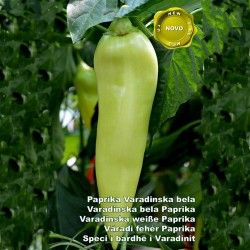
Varadinska White pepper seeds
Price
€1.65
(SKU: P 47)
Seeds Gallery EU,
5/
5
<h2><strong>Varadinska White pepper seeds</strong></h2>
<h2><span style="color: #ff0000;"><strong>Price for Package of 20 seeds.</strong></span></h2>
<p>Varadinska White pepper is a variety from Serbia. An early variety of pepper (from sprouting to technological maturity 118-120 days to biological 135-140 days), with long and large fruits. Excellent sweet taste, juicy, and crispy. Perfect for fresh consumption, barbeque, cooking, pickling. One of the favorite varieties in Serbia for making <span style="color: #0000ff;"><a href="https://www.google.com/search?q=lu%C4%8Dene+paprike&oq=lu%C4%8Dene+paprike&aqs=chrome..69i57j69i60&sourceid=chrome&ie=UTF-8" target="_blank" title=""lučene paprike"" style="color: #0000ff;" rel="noreferrer noopener"><strong>"lučene paprike"</strong></a></span></p>
<p>At full technological maturity, the fruits are milky white in color, while in biological ones they are intensely red. The plant forms hanging fruits 20-24cm long, 5-6 cm wide, 4-5mm thick meat-pericarp with an average weight of 120-130 grams.</p>
<p>It is suitable for year-round production in a protected area and achieves an extremely high yield potential in the open field (40-45 t / ha), with the application of appropriate agro-technical measures.</p>
P 47 (20 S)

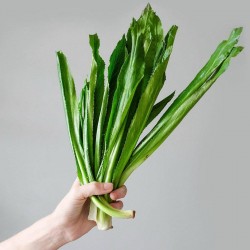
Mexican Coriander Seeds...
Price
€1.95
(SKU: MHS 32)
Seeds Gallery EU,
5/
5
<meta http-equiv="Content-Type" content="text/html; charset=UTF-8" />
<h2><strong>Mexican Coriander Seeds (Eryngium foetidum)</strong></h2>
<h2><span style="color: #ff0000;"><strong>Price for a Package of 20 seeds.</strong></span></h2>
<p>Eryngium foetidum is a tropical perennial herb in the family Apiaceae. Common names include culantro , recao, shadow beni, Mexican coriander, bhandhania, long coriander, sawtooth coriander, and ngò gai. It is native to Mexico, the Caribbean, Central and South America, but is cultivated worldwide, sometimes being grown as an annual in temperate climates.</p>
<p>In the United States, the common name culantro sometimes causes confusion with cilantro, a common name for the leaves of Coriandrum sativum (also in Apiaceae), of which culantro is said to taste like a stronger version.</p>
<p><strong>Uses</strong></p>
<p><strong>Culinary</strong></p>
<ol>
<li>foetidum is widely used in seasoning, marinating and garnishing in the Caribbean, particularly in Cuba, Dominican Republic, Puerto Rico, Trinidad and Tobago, Panama, Guyana, Suriname, and in Ecuador and Peru's Amazon regions. It is used extensively in Cambodia, Thailand, India, Vietnam, Laos,Myanmar and other parts of Asia as a culinary herb.[5] It dries well, retaining good color and flavor, making it valuable in the dried herb industry. It is sometimes used as a substitute for coriander, but it has a much stronger taste.</li>
</ol>
<p> </p>
<p>In the United States, E. foetidum grows naturally in Florida, Georgia, Hawaii, Puerto Rico, and the Virgin Islands.</p>
<p><strong>Traditional medicine</strong></p>
<ol>
<li>foetidum has been used in traditional medicine in tropical regions for burns, earache, fevers, hypertension, constipation, fits, asthma, stomachache, worms, infertility complications, snake bites, diarrhea, and malaria.</li>
<li>foetidum is also known as E. antihystericum.[8] The specific name antihystericum reflects the fact that this plant has traditionally been used for epilepsy.[9] The plant is said to calm a person's 'spirit' and thus prevents epileptic 'fits', so is known by the common names spiritweed and fitweed. The anticonvulsant properties of this plant have been scientifically investigated.[10][medical citation needed] A decoction of the leaves has been shown to exhibit anti-inflammatory and analgesic effects in rats.</li>
</ol>
<p>Eryngial is a chemical compound isolated from E. foetidum.[12] The University of the West Indies at Mona, Jamaica, has investigated the use of enyngial as a treatment for human Strongyloides stercoralis infection (strongyloidiasis).</p>
<p>It is used as an ethnomedicinal plant for the treatment of a number of ailments such as fevers, chills, vomiting, burns, fevers, hypertension, headache, earache, stomachache, asthma, arthritis, snake bites, scorpion stings, diarrhea, malaria and epilepsy.[medical citation needed] The main constituent of essential oil of the plant is eryngial (E-2-dodecenal). A pharmacological investigation claims to have demonstrated anthelmintic, anti-inflammatory, analgesic, anticonvulsant, anticlastogenic, anticarcinogenic, antidiabetic, and antibacterial activity.</p>
<p> </p>
MHS 32 (20 S)


Coming Soon
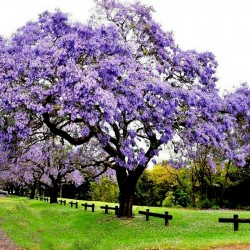
500 Seeds Paulownia Tomentosa
Price
€9.00
(SKU: T 14 T)
Seeds Gallery EU,
5/
5
<!DOCTYPE html>
<html>
<head>
<meta http-equiv="Content-Type" content="text/html; charset=UTF-8" />
</head>
<body>
<h2><strong>500 Seeds Paulownia Tomentosa (Empress, Foxglove Tree)</strong></h2>
<h2><span style="color: #ff0000;"><strong>Price for Package of 500 seeds.</strong></span></h2>
<div>
<div>Paulownia tormentosa is known by many names; regardless of what you want to call it, there is no doubt about its impressive ornamental features. This beautiful tree puts on an awe inspiring show in spring. Its soft chamois velvet buds open into large violet to blue, trumpet-like blossoms which fill the air with a sweet fragrance. The flowers carried on long up curved shoots, look like large foxgloves.</div>
<div>The huge leaves are an architectural delight: the soft, downy, large leaves appear after the flowers have opened.</div>
<div>Native to eastern Asia, this exotic looking, deciduous tree is surprisingly hardy and can tolerate harsh winters, to - 8*C (-14*F). Hardy throughout the British Isles, the buds of the Foxglove-like flowers are formed in the autumn and can be damaged by late frosts. They must be sheltered from hard frosts to ensure the violet blooms appear in spring.</div>
<div>It is a fast growing tree, usually grown as a specimen or shade tree. Growing rapidly (to 6f)t in it first year. In 3-5 years, this tree achieves what many other tree species take generations to achieve. An excellent use of this plant is the production of "stooled" specimens giving perhaps the most magnificent of all foliage dot plants. All growth is cut down to ground level each March and the resultant suckers reduced to a single shoot. The result is a strong, erect growth rising to 10 ft. and bearing huge and handsome leaves, producing a most striking effect. In very cold zones they are often grown and cut to near ground level in autumn and grown as a large-leafed shrub the following season.</div>
<div>Very easy to germinate, seedlings grow rapidly, flowering in as little as 2-3 years under good growing conditions.</div>
<div>It has been awarded the prestigious RHS Award of Garden Merit.</div>
<div>Named after the Princess of the Dutch region, Anna Paulowna, who died in 1865. It has never been found in the wild although it undoubtedly originated in China where an old custom is to plant an Empress Tree when a baby girl is born. The fast-growing tree matures as she does. When she is eligible for marriage the tree is cut down and carved into wooden articles for her dowry. Carving the wood of Paulownia is an art form in Japan and China.</div>
<div>Sowing: </div>
<div>Sow September to May</div>
<div>The seeds are very small so sow as thinly as possible to avoid crowding which leave seedlings more susceptible to damping off. Place the seeds on the surface of a tray containing well drained compost. Do not cover the seeds as light is required for germination.</div>
<div>Stand the tray in water to soak and either cover with a plastic dome or place the tray into a plastic bag. Temperatures should ideally not exceed 30*C (85*F) during the daytime and not below 18*C (60*F) at night. Always keep the soil mixture moist (not soaked) during the germination process. The seeds will germinate in 30 – 60 days and grow rapidly when conditions are favourable.</div>
<div>Growing: </div>
<div>After germination, remove the cover or bag. When seedlings are big enough to handle (about 2-3 weeks), carefully transfer to pots. Grow on until they are strong enough to plant into their permanent positions. Harden off before planting out (after the last expected frosts).</div>
<div>Aftercare: </div>
<div>Pruning should be done in autumn after leaf drop. prune down to where an axillary bud can take over as the single leader. Coppicing a tree annually sacrifices the flowers but produces 3m (10ft) stems with enormous leaves up to 60cm (2ft) across.</div>
<div>Plant Uses: </div>
<div>A specimen tree, shade tree, or focal point.</div>
<span style="font-size: 11px; line-height: 1.5em;">Fully hardy to -25°C.</span></div>
<div>
<table cellspacing="0" cellpadding="0" border="1">
<tbody>
<tr>
<td colspan="2" width="100%" valign="top">
<p><span style="color: #008000;"><strong>Sowing Instructions</strong></span></p>
</td>
</tr>
<tr>
<td valign="top" nowrap="nowrap">
<p><span style="color: #008000;"><strong>Propagation:</strong></span></p>
</td>
<td valign="top">
<p><span style="color: #008000;">Seeds</span></p>
</td>
</tr>
<tr>
<td valign="top" nowrap="nowrap">
<p><span style="color: #008000;"><strong>Pretreat:</strong></span></p>
</td>
<td valign="top">
<p><span style="color: #008000;">0</span></p>
</td>
</tr>
<tr>
<td valign="top" nowrap="nowrap">
<p><span style="color: #008000;"><strong>Stratification:</strong></span></p>
</td>
<td valign="top">
<p><span style="color: #008000;">0</span></p>
</td>
</tr>
<tr>
<td valign="top" nowrap="nowrap">
<p><span style="color: #008000;"><strong>Sowing Time:</strong></span></p>
</td>
<td valign="top">
<p><span style="color: #008000;">all year round </span></p>
</td>
</tr>
<tr>
<td valign="top" nowrap="nowrap">
<p><span style="color: #008000;"><strong>Sowing Depth:</strong></span></p>
</td>
<td valign="top">
<p><span style="color: #008000;">Light germinator! Only sprinkle on the surface of the substrate + slightly press on</span></p>
</td>
</tr>
<tr>
<td valign="top" nowrap="nowrap">
<p><span style="color: #008000;"><strong>Sowing Mix:</strong></span></p>
</td>
<td valign="top">
<p><span style="color: #008000;">Coir or sowing mix + sand or perlite</span></p>
</td>
</tr>
<tr>
<td valign="top" nowrap="nowrap">
<p><span style="color: #008000;"><strong>Germination temperature:</strong></span></p>
</td>
<td valign="top">
<p><span style="color: #008000;">22-25°C</span></p>
</td>
</tr>
<tr>
<td valign="top" nowrap="nowrap">
<p><span style="color: #008000;"><strong>Location:</strong></span></p>
</td>
<td valign="top">
<p><span style="color: #008000;">bright + keep constantly moist not wet</span></p>
</td>
</tr>
<tr>
<td valign="top" nowrap="nowrap">
<p><span style="color: #008000;"><strong>Germination Time:</strong></span></p>
</td>
<td valign="top">
<p><span style="color: #008000;">4-6 weeks</span></p>
</td>
</tr>
<tr>
<td valign="top" nowrap="nowrap">
<p><span style="color: #008000;"><strong>Watering:</strong></span></p>
</td>
<td valign="top">
<p><span style="color: #008000;">Water regularly during the growing season</span></p>
</td>
</tr>
<tr>
<td valign="top" nowrap="nowrap">
<p><span style="color: #008000;"><strong> </strong></span></p>
</td>
<td valign="top">
<p><br /><span style="color: #008000;"><em>Copyright © 2012 Seeds Gallery - Saatgut Galerie - Galerija semena. </em><em>All Rights Reserved.</em><em></em></span></p>
</td>
</tr>
</tbody>
</table>
</div>
</body>
</html>
T 14 T

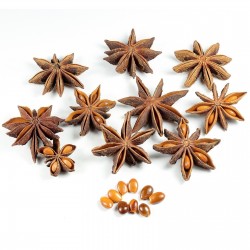
Star Anise Seeds (Illicium...
Price
€3.50
(SKU: MHS 116)
Seeds Gallery EU,
5/
5
<h2 class=""><strong>Star Anise Seeds (Illicium verum)</strong></h2>
<h2><span style="color: #ff0000;"><strong>Price for Package of 3 seeds.</strong></span></h2>
<p><i><b>Illicium verum</b></i><span> </span>is a medium-sized<span> </span>evergreen<span> </span>tree native to northeast<span> </span>Vietnam<span> </span>and southwest China. A spice commonly called<span> </span><b>star anise</b>,<span> </span><b>staranise</b>,<span> </span><b>star anise seed</b>,<span> </span><b>Chinese star anise</b>, or<span> </span><b>badiane</b><span> </span>that closely resembles<span> </span>anise<span> </span>in flavor is obtained from the star-shaped<span> </span>pericarps<span> </span>of the fruit of<span> </span><i>I. verum</i><span> </span>which are harvested just before ripening. Star anise oil is a highly fragrant oil used in cooking, perfumery, soaps, toothpastes, mouthwashes, and skin creams. About 90% of the world's star anise crop is used for extraction of<span> </span>shikimic acid, a chemical intermediate used in the synthesis of<span> </span>oseltamivir<span> </span>(Tamiflu).</p>
<h2><span class="mw-headline" id="Nomenclature">Nomenclature</span></h2>
<table class="infobox">
<tbody>
<tr>
<td colspan="2">Star anise</td>
</tr>
<tr>
<th scope="row">Chinese</th>
<td><span lang="zh-hani" title="Chinese language text" xml:lang="zh-hani">八角</span></td>
</tr>
<tr>
<th scope="row">Literal meaning</th>
<td>"eight-horns"</td>
</tr>
<tr>
<td colspan="2">
<table class="collapsible collapsed mw-collapsible mw-collapsed mw-made-collapsible">
<tbody>
<tr>
<th colspan="2"><span class="mw-collapsible-toggle mw-collapsible-toggle-default mw-collapsible-toggle-collapsed">show</span>Transcriptions</th>
</tr>
</tbody>
</table>
</td>
</tr>
</tbody>
</table>
<p><i>Illicium</i><span> </span>comes from the Latin<span> </span><i>illicio</i><span> </span>meaning "entice". In<span> </span>Persian, star anise is called<span> </span><span lang="fa" title="Persian language text" xml:lang="fa">بادیان</span><span> </span><i>bādiyān</i>, hence its French name<span> </span><i><i>badiane</i></i>.</p>
<h2><span class="mw-headline" id="Use">Use</span></h2>
<h3><span class="mw-headline" id="Culinary_use">Culinary use</span></h3>
<div class="thumb tright">
<div class="thumbinner"><img alt="" src="https://upload.wikimedia.org/wikipedia/commons/thumb/a/aa/Star_Aniseed_back.jpg/220px-Star_Aniseed_back.jpg" width="220" height="190" class="thumbimage" />
<div class="thumbcaption">
<div class="magnify"></div>
Reverse side of fruit</div>
</div>
</div>
<div class="thumb tright">
<div class="thumbinner"><img alt="" src="https://upload.wikimedia.org/wikipedia/commons/thumb/f/f2/Illicium_verum00.jpg/220px-Illicium_verum00.jpg" width="220" height="396" class="thumbimage" />
<div class="thumbcaption">
<div class="magnify"></div>
Plate from<span> </span>François-Pierre Chaumeton's 1833<span> </span><i>Flore Medicale</i></div>
</div>
</div>
<p>Star anise contains<span> </span>anethole, the same compound that gives the unrelated<span> </span>anise<span> </span>its flavor. Recently, star anise has come into use in the<span> </span>West<span> </span>as a less expensive substitute for anise in baking, as well as in<span> </span>liquor<span> </span>production, most distinctively in the production of the<span> </span>liqueur<span> </span>Galliano.<sup id="cite_ref-2" class="reference">[2]</sup><span> </span>Star anise enhances the flavour of meat.</p>
<p>It is used as a spice in preparation of<span> </span><i>biryani</i><span> </span>and<span> </span><i>masala chai</i><span> </span>all over the<span> </span>Indian subcontinent. It is widely used in<span> </span>Chinese cuisine, and in<span> </span>Malay<span> </span>and<span> </span>Indonesian cuisines. It is widely grown for commercial use in China, India, and most other countries in Asia. Star anise is an ingredient of the traditional<span> </span>five-spice powder<span> </span>of Chinese cooking. It is also a major ingredient in the making of<span> </span><i>phở</i>, a<span> </span>Vietnamese<span> </span>noodle soup.</p>
<p>It is also used in the French recipe of mulled wine, called<span> </span><i>vin chaud</i><span> </span>(hot wine). If allowed to steep in coffee, it deepens and enriches the flavor. The pods can be used in this manner multiple times by the pot-full or cup, as the ease of extraction of the taste components increases with the permeation of hot water.</p>
<h3><span class="mw-headline" id="Drug_precursor">Drug precursor</span></h3>
<div class="hatnote navigation-not-searchable">Main article:<span> </span>Oseltamivir total synthesis</div>
<p>Star anise is the major source of the chemical compound<span> </span>shikimic acid, a primary<span> </span>precursor<span> </span>in the<span> </span>pharmaceutical<span> </span>synthesis of the antiinfluenza<span> </span>drug,<span> </span>oseltamivir<span> </span>(Tamiflu).<sup id="cite_ref-Bilal_4-0" class="reference">[4]</sup><sup id="cite_ref-Drugs_5-0" class="reference">[5]</sup><sup id="cite_ref-Wang_6-0" class="reference">[6]</sup>An industrial method for the production of shikimic acid using<span> </span>fermentation<span> </span>of<span> </span><i>E. coli</i><span> </span>bacteria was discovered in 2005,<sup id="cite_ref-7" class="reference">[7]</sup><sup id="cite_ref-8" class="reference">[8]</sup><span> </span>and applied in the<span> </span>2009 swine flu outbreak<span> </span>to address Tamiflu shortages, also causing price increases for star anise as a<span> </span>raw material<span> </span>of shikimic acid.<sup id="cite_ref-lim_9-0" class="reference">[9]</sup><span> </span>As of 2018, fermentation of<span> </span><i>E. coli</i><span> </span>was the manufacturing process of choice to produce shikimic acid for synthesis of Tamiflu.<sup id="cite_ref-Drugs_5-1" class="reference"></sup></p>
<h2><span class="mw-headline" id="Toxicity">Toxicity</span></h2>
<p>Japanese star anise<span> </span>(<i>Illicium anisatum</i>), a similar tree, is highly toxic and inedible; in Japan, it has instead been burned as<span> </span>incense. Cases of illness, including "serious<span> </span>neurologicaleffects, such as seizures", reported after using star anise tea, may be a result of deliberate<span> </span>economically motivated adulteration<span> </span>with this species. Japanese star anise contains the<span> </span>neurotoxin<span> </span>anisatin,<sup id="cite_ref-PubChem_10-0" class="reference">[10]</sup><span> </span>which also causes severe<span> </span>inflammation<span> </span>of the<span> </span>kidneys<span> </span>(nephritis),<span> </span>urinary tract, and<span> </span>digestive organs<span> </span>when ingested.</p>
<p>Swamp star anise<span> </span><i>Illicium parviflorum</i><span> </span>is a similar tree found in the Southern United States, and due to its toxicity, it should not to be used for folk remedies or as a cooking ingredient.</p>
<h2><span class="mw-headline" id="Standardization_of_its_products_and_services">Standardization of its products and services</span></h2>
<ul>
<li>ISO 676:1995 - contains the information about the nomenclature of the variety and cultivars</li>
</ul>
<h3><span class="mw-headline" id="Identification">Identification</span></h3>
<ul>
<li>Refer to the 4th edition of the<span> </span><i>European Pharmacopoeia</i><span> </span>(1153)</li>
</ul>
<h3><span class="mw-headline" id="Differentiation_from_other_species">Differentiation from other species</span></h3>
<p>Joshi<span> </span><i>et al.</i><span> </span>have used<span> </span>fluorescent microscopy<span> </span>and<span> </span>gas chromatography<sup id="cite_ref-reiivh_14-0" class="reference">[14]</sup><span> </span>to distinguish the species, while Lederer<span> </span><i>et al.</i><span> </span>employed<span> </span>thin layer chromatography<span> </span>with<span> </span>HPLC-MS/MS</p>
<p><span style="color: inherit; font-family: inherit; font-size: 30px;">How to Grow Star Anise From Seeds</span></p>
<p>Star anise trees (<em>Illicium verum</em>) grow easily from seed. Star anise trees grow in U.S. Department of Agriculture plant hardiness zones 7 through 10 and do best with a soil pH between 4 and 6 that's rich in organic matter. They grow in either full sun or part shade.</p>
<p><span style="color: inherit; font-family: inherit; font-size: 30px;">Preparing and Planting Star Anise Seeds</span></p>
<p>Carefully preparing and planting the seeds will give the best chance of success. Or, store the seeds in moist sand in a sealed plastic bag or container in the refrigerator for up to a month.</p>
<p><span style="color: inherit; font-family: inherit; font-size: 30px;">Step 1</span></p>
<p>Pour seed-starting potting mix into 4- to 6-inch-diameter plastic pots. Fill them to 1 to 1 1/2 inches from the top. Moisten the mix with room-temperature water. Use pots that have drainage holes in them.</p>
<p><span style="color: inherit; font-family: inherit; font-size: 30px;">Step 2</span></p>
<p>Place the seeds into a bowl filled with water. Throw away any seeds that <strong>float</strong> to the surface. They are not viable. Plant only the seeds that sink to the bottom.</p>
<p><span style="color: inherit; font-family: inherit; font-size: 30px;">Step 3</span></p>
<p>Place two or three seeds per pot on top of the moistened potting mix, spaced evenly apart. Cover the seeds with a 1/4 to 1/2 inch of a moistened seed-starting mix. Firm it gently with your fingers to remove air pockets. Set plastic water or soda bottle with the bottom cut out over the seeds. Leave the screw caps on.</p>
<p><span style="color: inherit; font-family: inherit; font-size: 30px;">Step 4</span></p>
<p>Put the containers in bright, indirect light where temperatures stay around 70 degrees Fahrenheit. Moisten the potting mix using a spray bottle with room-temperature water if it begins to dry or set the containers in 1 to 2 inches of room-temperature water for an hour or two. The water will soak up into the germination mix through the holes in the bottoms of the containers.</p>
<p><span style="color: inherit; font-family: inherit; font-size: 30px;">Step 5</span></p>
<p>Remove the screw caps from the tops of the bottles after the seeds germinate. Remove the bottles a week later. The seeds should germinate in <strong>one to two months</strong>.</p>
<p><span style="color: inherit; font-family: inherit; font-size: 30px;">Step 6</span></p>
<p>Pot the star anise tree seedlings up in individual 6- to 8-inch pots when they are 3 to 4 inches tall. Use pots with drainage holes. Pot them up using <strong>peat-based</strong> potting soil. Set them in bright, indirect light and water them with room-temperature water when the top of the potting soil begins to dry.</p>
<p><span style="color: inherit; font-family: inherit; font-size: 30px;">Step 7</span></p>
<p>Grow the star anise plants in their containers for one year. Repot them into containers 1 inch larger when they become pot-bound or when you can see the roots through the drain holes in the bottom of the container. <strong>Set them outdoors</strong> during the day in the summer when there is no danger of frost and the weather is calm and pleasant. Put them in bright shade in an area that is protected from strong winds. Continue to water them when the top of the soil begins to dry.</p>
<p><span style="color: inherit; font-family: inherit; font-size: 30px;">Step 8</span></p>
<p>Plant them outdoors in their permanent positions the following spring after any danger of frost has passed. Begin to get them used to direct sunlight two weeks before planting. Start with an hour of direct morning sunlight and increase the duration by 30 minutes or so every two days. Water them when the top 2 inches of soil feel dry. Plant multiple trees 15 to 20 feet apart. Water them generously right after planting and continue to water them as often as necessary to keep the soil lightly moist.</p>
<script src="//cdn.public.n1ed.com/G3OMDFLT/widgets.js"></script>
MHS 116 (3 S)


Variety from Croatia
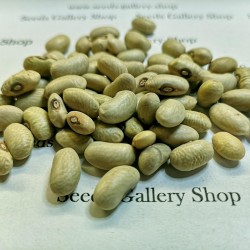
Green Beans Seeds SLAVONSKI...
Price
€1.35
(SKU: VE 44 (10g))
Seeds Gallery EU,
5/
5
<h2><strong>Green Beans Seeds “Slavonski Zeleni”</strong></h2>
<h2 class=""><span style="color: #ff0000;"><strong>Price for Package of 20 (10g) seeds.</strong></span></h2>
<p>Originated from the coastal Danube plains in Serbia and Croatia. This variety is of low growth about 40 cm, excellent taste, early variety, low, greenish grain. The shape of the grain is cylindrical-elliptical. Vegetation, 70-75 days.</p>
<p>The absolute weight of 1000 grains amounts to 330-380 g.</p>
<p>Sowing:</p>
<p>Optimal sowing period: April</p>
<p>Sowing depth: 4 - 5 cm</p>
<p>Distance between rows: 50 cm</p>
<p>Distance in a row: 5 cm</p><script src="//cdn.public.n1ed.com/G3OMDFLT/widgets.js"></script>
VE 44 (10g)

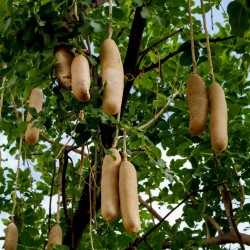
Sausage Tree Seeds (Kigelia...
Price
€2.05
(SKU: T 81)
Seeds Gallery EU,
5/
5
<meta http-equiv="Content-Type" content="text/html; charset=UTF-8" />
<h2><strong>Sausage Tree Seeds (Kigelia pinnata)</strong></h2>
<h2><span style="color: #ff0000;"><strong>Price for Package of 5 seeds.</strong></span></h2>
<p>Kigelia is a genus of flowering plants in the family Bignoniaceae. The genus consists of only one species, Kigelia africana, which occurs throughout tropical Africa, from Eritrea and Chad south to northern South Africa, and west to Senegal and Namibia. Common in India, with many medicinal uses, the species's distribution is most certainly anthropogenic. The sausage tree grows a fruit that is up to 2 feet long, weighs about 15 lbs, and looks like a sausage.</p>
<p>The genus name comes from the Mozambican Bantu name, kigeli-keia, while the common names sausage tree and cucumber tree refer to the long, sausage-like fruit. Its name in Afrikaans worsboom also means sausage tree, and its Arabic name means "the father of kit-bags".</p>
<p><strong>Habitat</strong></p>
<p>It is a tree growing up to 20 m (66 feet) tall and it typically has spreading branches. The bark is grey and smooth at first, peeling on older trees. It can be as thick as 6 mm on a 15-cm diameter branch. The wood is pale brown or yellowish, undifferentiated and not prone to cracking.</p>
<p><strong>Foliage</strong></p>
<p>The tree is evergreen where rainfall occurs throughout the year, but deciduous where there is a long dry season. The leaves are opposite or in whorls of three, 12 to 20 inches (30–50 cm) long, pinnate, with six to ten oval leaflets up to eight inches (20 cm) long and 2.25 inches (6 cm) broad; the terminal leaflet can be either present or absent.</p>
<p><strong>Flowers</strong></p>
<p>The flowers (and later the fruit) hang down from branches on long flexible stems (2–6 metres long). Flowers are produced in panicles; they are bell-shaped (similar to those of the African tulip tree but broader and much darker and more waxy), orange to maroon or purplish green, and about four inches (10 cm) wide. Individual flowers do not hang down but are oriented horizontally.</p>
<p><strong>Fruit</strong></p>
<p>The fruit is a woody berry from 12 to 39 inches (30–100 cm) long[3] and up to seven inches (18 cm) broad, but eight inches (20 cm) has been reported.[4] Typically it weighs between 11 and 22 pounds (5 and 10 kg) but occasionally up to 26 pounds (12 kg),[5] and hangs down on long, rope-like peduncles. The fruit pulp is fibrous, containing many seeds.</p>
<p><strong>Species associations</strong></p>
<p>Some birds are attracted to the flowers and the strong stems of each flower make ideal footholds. Their scent is most notable at night indicating that they are adapted to pollination by bats, which visit them for pollen and nectar. The flowers also remain open by day however, and are freely visited by many insect pollinators, particularly large species such as carpenter bees. The fruit are eaten by several species of mammals, including baboons, bushpigs, savannah elephants, giraffes, hippopotamuses, monkeys, and porcupines. The seeds are dispersed in their dung. The seeds are also eaten by brown parrots and brown-headed parrots, and the tree's foliage by elephants and greater kudu (Joffe 2003; del Hoyo et al. 1997). Introduced specimens in Australian parks are very popular with cockatoos.</p>
<p><strong>Cultivation and uses</strong></p>
<p>The fresh fruit is poisonous and strongly purgative; fruit are prepared for consumption by drying, roasting or fermentation (Joffe 2003; McBurney 2004). Kigelia is also used in a number of skin care products. In Botswana, the timber is used for makoros, yokes and oars.</p>
<p>The hard shell (skin) of the fruit can be hollowed out, cleaned, and made into useful, durable containers of varying sizes.</p>
<p>The tree is widely grown as an ornamental tree in tropical regions for its decorative flowers and unusual fruit. Planting sites should be selected carefully, as the falling fruit can cause serious injury to people and damage vehicles parked under the trees.</p>
<p>In Central Kenya, especially among the Agikuyu and the Akamba, the dried fruits are used to make an alcoholic beverage (muratina in Kikuyu, kaluvu in Kamba), which is a core component in cultural events in Central Kenya. The fruit is harvested then split into two along the grain, then dried in the sun. The dried fruit is then treated with bee pollen and honey. The treated fruit (miatine) is then used in fermentation process in making of sweet beer.</p>
T 81 (5 S)


Variety from Austria
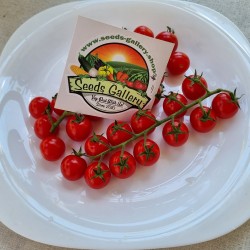
BLUE ANGEL Vine Cherry...
Price
€1.75
(SKU: VT 5)
Seeds Gallery EU,
5/
5
<h2><strong>BLUE ANGEL Vine Cherry Tomato Seeds</strong></h2>
<h2><span style="color: #ff0000;"><strong>Price for Package of 10 seeds.</strong></span></h2>
<p>Tomato variety from Austria. Super sweet perfectly round fruits are 2,5 - 3 cm in diameter, and have a weight of 10 grams and 14 fruits per cluster. Plants are very robust and do not need special care.</p>
<p>Vine tomatoes have a unique aromatic-sweet taste, which makes them particularly popular. Due to the panicle, they retain their strong tomato aroma over a longer period of time.</p>
VT 5 (10 S)

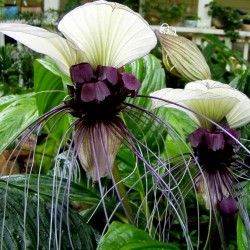
White Bat Flower Seeds...
Price
€2.85
(SKU: F 66 W)
Seeds Gallery EU,
5/
5
<h2><span style="font-size:14pt;"><strong>White Bat Flower Seeds (Tacca chantrieri)</strong></span></h2>
<h2><span style="color:#ff0000;font-size:14pt;"><strong>Price for Package of 4 seeds.</strong></span></h2>
<p>Tacca chantrieri, the black bat flower, is a species of flowering plant in the yam family Dioscoreaceae. Tacca chantrieri is an unusual plant in that it has black flowers. These flowers are somewhat bat-shaped, are up to 12 inches across, and have long 'whiskers' that can grow up to 28 inches. There are ten species in the genus Tacca. One of these, T. integrifolia, is commonly called the "white bat plant." T. integrifolia is similar to T. chantrieri, but has white bracts which are veined purple. T. integrifolia is larger than T. chantrieri, reaching up to four feet in height (almost twice the size of T. chantrieri at a height of 24"-36").</p>
<p>Tacca chantrierei is native to tropical regions of Southeast Asia including Thailand, Malaysia, and southern China: particularly Yunnan Province. They are understory plants, so they prefer shade (at least 60%). They grow best in well-drained soil with good air circulation, but they prefer high humidity, and need a lot of water. They are hardy to USDA zones 11, above 4.5 °C (40 °F).</p>
F 66 W


Transparent Clear Test Tube...
Price
€0.28
(SKU: PE 3 (2ml))
Seeds Gallery EU,
5/
5
<h2><span style="font-size: 14pt;"><strong>Transparent Clear Test Tube With lid 2 ml </strong></span></h2>
<h3><span style="color: #ff0000; font-size: 14pt;"><strong>Price is for 1 Test Tube.</strong></span></h3>
<p>Ideal for storing seeds or some other things.</p>
<p>The lid is perfectly closed and therefore, so you can hold also liquids.</p>
<p>Disposable plastic centrifuge tube with cap.</p>
<p>Made of pp material, heat resistance up to 150 degrees, no bubble without impurities.</p>
<p>Pointed bottom, flexible cover, easy to open.</p>
<p><strong>Specification:</strong><br><span>External Diameter: 13cm/0.51"</span><br><span>Inner Dia: 0.9cm/0.35"</span><br><span>length: 4.2cm/1.65"</span><br><span>Size: L 1.65" x W 0.75"</span><br><span>Material: Polypropylene</span><br><span>Color: Transparent</span></p>
<script src="//cdn.public.n1ed.com/G3OMDFLT/widgets.js"></script>
PE 3 (2ml)

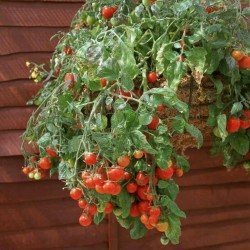
Red & Yellow Tumbling Tom...
Price
€1.55
(SKU: VT 145)
Seeds Gallery EU,
5/
5
<h2><strong>Red & Yellow Tumbling Tom Tomato Seeds</strong></h2>
<h2><span style="color:#ff0000;"><strong>Price for Package of 5 seeds.</strong></span></h2>
<p>Trade flowering hanging baskets for pretty-as-a-picture trailing tomatoes. Tumbling Tom Red plants cascade from hanging baskets, tall containers, or window boxes, and when they’re loaded with sparkling red fruit, the effect is striking. Anticipate a harvest of up to four pounds of tomatoes per plant, with new fruit ripening throughout the summer. These plants have a trailing growth habit, so they don’t need staking. Tuck one to two into a tall pot or large hanging basket. Resistant to fusarium wilt, verticillium wilt, and nematodes.</p>
<p>Light Full sun</p>
<p>Fruit weight 15-20g</p>
<p>Matures 63 to 70 days</p>
<p>Plant spacing 10 inches apart</p>
<p>Plant size 30-50 cm</p>
<p>Plant type compact determinate (cascading)</p>
VT 145 Y (5 S)


Coming Soon
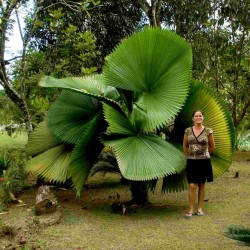
Ruffled fan Palm Seeds...
Price
€4.80
(SKU: PS 12)
Seeds Gallery EU,
5/
5
<meta http-equiv="Content-Type" content="text/html; charset=UTF-8" />
<h3><span style="font-size: 14pt;"><strong>Ruffled fan Palm Seeds (Licuala grandis)</strong> </span></h3>
<h3><span style="font-size: 14pt;"><strong><span style="color: #f00404;">Price for Package of 3 seeds.</span></strong></span></h3>
<p>Ruffled fan palm is perhaps one of the most interesting and elegant of all small palms. Its glossy, pleated, fan-like fronds are fantastic as are its drooping cluster of red fruits that mature late in the season. This evergreen, frost-tender palm is native to the wet, humid rainforests of the Republic of Vanuatu and the Solomon Islands east of Australia. It's a small understory palm that’s ideal for small, tropical landscapes as well as interiorscapes.</p>
<p><span>Atop the thin, fiber covered trunk of this palm is a crown of twelve to twenty beautiful leaves. Each glossy, deep green frond is wedge-shaped and looks as if it’s been pleated. The frond stems (petioles) are long and have sharp, curved teeth at the base. Most are held upright but the oldest arch gracefully. In early or midsummer, a cluster of yellowish white blossoms appear. These develop into small, round, red fruits by autumn.</span></p>
<p><span>Grow ruffled fan palm in partial shade or dappled sun when small and young. Older specimens will tolerate more sun if humidity is high and summer temperatures not too scorching. Although there are Licuala grandis known to have survived temperatures of -1.5° C. it is advisable to plant this palm in regions only where temperatures do not fall below 3 degrees C. For good health plant in a fast-draining soil that’s fertile and evenly moist. Sandy soil amended with lots of humus is ideal. For dramatic landscape effect, cluster ruffled fan palm beneath a tall shade tree or shaded building foundation. Indoors it will become a nice container specimen as long as it receives very bright light, warmth and its soil never becomes dry. This palm responds favorably to frequent, light fertilization.</span></p>
<p><span>Solitary trunk of up to 3 m in height and 5-6 cm in diam., Leaf circular, undivided and regularly pleated leaf; about 22 inch or more in diameter with a notched edge, with the old dry leaves persisting.</span> </p>
<p><a href="https://www.youtube.com/watch?v=Hx6WBaQ1h5M" target="_blank" class="btn btn-default" rel="noreferrer noopener">Ruffled fan Palm (Licuala grandis)</a></p>
<p><strong><span>Scientific name:</span></strong><span> Licuala grandis</span></p>
<p><strong><span>Common names</span></strong><span>: The Ruffled Fan Palm is also known Vanuatu Fan Palm, Palas Palm, and Ruffled Lantan Palm.</span></p>
<p><strong><span>Family:</span></strong><span> Arecaceae</span></p>
<p><strong><span>Origin:</span></strong><span> It is native to the Vanuatu Islands, off the coast of Australia.</span></p>
<p><strong><span>Appearance:</span></strong><span> It has a single slender trunk, 4-5 inches in diameter that takes years to develop. The Ruffled Fan Palm is known for its unique palmate, or fan-shape leaves, with attractive splitting patterns that make it stand out in any environment. Leaves are circular, luscious green, glossy, ruffled, hence the name Ruffled Fan Palm, about 22 inches in diameter, with notched tips.</span></p>
<p><strong><span>Flowers/Fruits:</span></strong><span> The inflorescence emerges from among the leaves bearing bisexual flowers, male and female reproductive organs grow on the same flower. Ruffled Fan Palm produces marble-like green fruit that turns red when ripe. This berry looking fruit is round with a single seed inside.</span></p>
<p><strong><span>Growth Rate:</span></strong><span> Slow. Licuala grandis is a very attractive, slow growing palm that can get up to 5-10ft tall, but usually doesn’t get higher than 6ft with a spread of 5-10ft wide.</span></p>
<p><strong><span>Outdoor/Indoor Use:</span></strong><span> Both.</span></p>
<p><strong><span>Cold Tolerance:</span></strong><span> It can tolerate cold down to 30F when mature enough. It is great for growing in USDA Zones 10a (30 to 35 F) to 11 (above 40 F).</span></p>
<p><strong><span>Light Req:</span></strong><span> Partial shade. It grows best in partial shade and should not be exposed to full sun.</span></p>
<p><strong><span>Water Req:</span></strong><span> High. It needs a lot of water with good drainage</span></p>
<p><strong><span>Maintenance:</span></strong><span> Easy. Make sure to protect it from high winds to avoid frond damage. To prevent nutritional deficiency, apply good quality palm fertilizer that has continuous release formula twice a year during growing season.</span></p>
<p><strong><span>Propagation:</span></strong><span> Propagated by seed. It might take as long as 12 months for seeds to sprout.</span></p>
PS 12 (3 S)

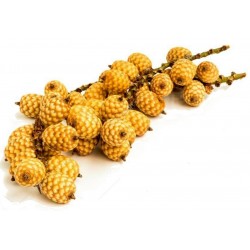
Rattan Seeds (Calamus manan)
Price
€4.50
(SKU: PS 11)
Seeds Gallery EU,
5/
5
<h2><span style="font-size: 14pt;" data-mce-style="font-size: 14pt;" class="n1ed--selected"><strong>Rattan Seeds (Calamus manan)</strong></span></h2><h2><span style="color: #fb0101; font-size: 14pt;" data-mce-style="color: #fb0101; font-size: 14pt;"><strong>Price for Package of 3 seeds.</strong></span></h2><p><span>Calamus manan is a robust, single stemmed, high-climbing, dioecious rattan. Plants produce a strong durable cane up to 8 cm in diameter, with internodes to 40 cm in length, and with stems eventually reaching to over 100 m. Growth rates of over 7 m a year have been inferred from observation of plants in Sabah (Dransfield and Tan, pers. obs. 1989), but more usually 1-3 m or more a year. Leaves cirrate to 8 m long including the cirrus to 3 m long. Petiole short, leaflets irregular in juvenile leaves and regular in mature leaves, to 45 on each side of rachis, lanceolate. Inflorescences massive, the male much more finely branched than the female, 70 cm long. Ripe fruit rounded to ovoid, to 2.8 cm long by 2.0 cm wide and covered with 15 vertical rows of yellowish scales with blackish-brown margins. Seed ovoid, to 1.8 cm by 1.2 cm, with finely pitted surface.</span></p><p><span>Solitary massive high climbing rattan, reaching eventually lengths of over 100 m. Stem without sheaths to 8 cm in diameter, sometimes quite slender (2.5 cm) at the very base, with sheaths to 11 cm in diameter; internodes to 40 cm long. Sheaths dull grey green densely armed with black laminate hairy edged triangular spines arranged in lateral groups or scattered, the largest to J cm long by 1 cm wide at the base, and with numerous much smaller spines to 5 mm long between; spines horizontal or slightly reflexed; thin white wax abundant between spines. Knee conspicuous armed as leaf sheath. Ocrea ill-defined. Leaf cirrate very massive to 8 m long including the cirrus to 3 m long; petiole short, to 12 cm long by 5 cm wide in mature plants, much longer in juveniles armed densely as is the rachis with short triangular spines both on the upper surface and beneath, with scattered grey in dumentum between. Leaflets irregular in juvenile leaves, regular in mature leaves, limply pendulous and versatile, to 45 on each side, pale grey-green, the largest to 60 cm long by 6 cm wide bristly near the tips. Inflorescences massive, the male much more finely branched than the female, to 2.5 m long with up to 9 partial inflorescences on each side to 70 cm long; all bracts rather densely armed with triangular spines to 3 mm high and red-brown in dumentum. Rachillae to 15 cm long. Ripe fruit rounded to ovoid, to 2.8 cm long by 2.0 cm wide shortly beaked, and covered in 15 vertical rows of yellowish scales with blackish brown margins. Seed ovoid, to 1.8 cm long by 1.2 cm wide, with finely pitted surface; endosperm densely and deeply ruminate. Seedling leaf with 2 divergent leaflets cucullate with a waxy blue-grey bloom on a pale dull green surface. (J. Dransfield, A Manual of the rattans of the Malay Peninsula. Malayan Forest Records 29.. 1979)/Palmweb. Editing by edric.</span></p><p><span>"Rotan manau" is widespread, but usually confined to steep slopes in hill Dipterocarp forest. It is rather rarely found in lowland Dipterocarp forest, and there, nearly always on steep slopes. It has an altitudinal range of about 50-1000 m and is at present most abundant between 600 and 1000 m altitude. It is likely however that it was formerly much more widespread, with its range being limited now by over exploitation. Seedlings are very characteristic and often abundant in hill forest. Calamus manan is variable in size and coloration. Beccari originally separated Malayan material as a separate species (C. giganteus) but I consider this to be conspecific with C. manan. Novices sometimes confuse "rotan manau" with "rotan dok" which is also very large and often grows with it. However, "rotan dok" is immediately distinguished because it has a flagellum and no cirrus whereas "rotan manau" has a cirrus but no flagellum. Calamus tumidus is very close to C. manan but can be separated on its smaller size, different leaf sheath armature and the very large bulbous, swollen knee. (J. Dransfield, A Manual of the rattans of the Malay Peninsula. </span>Malayan Forest Records 29.. 1979)/Palmweb.</p>
PS 11 (3 S)


Plant resistant to cold and frost
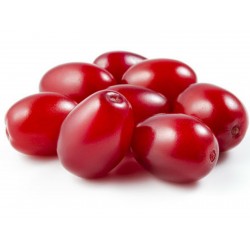
Cornelian Cherry, European...
Price
€2.05
(SKU: V 217)
Seeds Gallery EU,
5/
5
<!DOCTYPE html>
<html>
<head>
<meta http-equiv="Content-Type" content="text/html; charset=UTF-8" />
</head>
<body>
<h2><strong>Cornelian Cherry, European Cornel Seeds (Cornus mas)</strong></h2>
<h2><span style="color: #ff0000;">Price for Package of 10 seeds.</span></h2>
<p>Cornus mas (Cornelian cherry, European cornel or Cornelian cherry dogwood) is a species of flowering plant in the dogwood family Cornaceae, native to southern Europe (from France to Ukraine) and southwestern Asia including Armenia, Azerbaijan, Georgia, Iran, Turkey, Israel, Lebanon and Syria.</p>
<p>It is a medium to a large deciduous shrub or small tree growing to 5–12 m tall, with dark brown branches and greenish twigs. The leaves are opposite, 4–10 cm long and 2–4 cm broad, with an ovate to oblong shape and an entire margin. The flowers are small (5–10 mm diameter), with four yellow petals, produced in clusters of 10–25 together in the late winter (between February and March in the UK),[1] well before the leaves appear. The fruit is an oblong red drupe 2 cm long and 1.5 cm in diameter, containing a single seed.</p>
<h3><strong><em>Uses</em></strong></h3>
<h3><strong>Fruit</strong></h3>
<p>The fruits when ripe on the plant bear a resemblance to coffee berries, and ripen in mid- to late summer. The fruit is edible (mainly consumed in Eastern Europe, UK,[1] and Iran), but the unripe fruit is astringent. The fruit only fully ripens after it falls from the tree. When ripe, the fruit is dark ruby red or a bright yellow. It has an acidic flavor which is best described as a mixture of cranberry and sour cherry; it is mainly used for making jam, makes an excellent sauce similar to cranberry sauce when pitted and then boiled with sugar and orange, but also can be eaten dried. In Azerbaijan and Armenia, the fruit is used for distilling vodka, in Austria and German Alps is used for distilling Dirndlbrand, in Albania and Bosnia and Herzegovina it is distilled into raki, and in Greece crana berries are used to make a home-made liqueur. In Turkey and Iran it is eaten with salt as a snack in summer, and traditionally drunk in a cold drink called kızılcık şerbeti. Cultivars selected for fruit production in Ukraine have fruit up to four cm long. It is eaten in Eastern Europe in many ways including as a medicine. It is very high in vitamin C and is used to fight colds and flus.</p>
<p> </p>
<p>The fruit of C. mas (together with the fruit of C. officinalis) has a long history of use in traditional Chinese medicine. Known as shan zhu yu, 山茱萸, it is used to retain the jing, essence, to tonify the kidneys, and in cases of spermatorrhea.</p>
<h3><strong>Flowers</strong></h3>
<p>The species is also grown as an ornamental plant for its late winter yellow flowers, which open earlier than those of Forsythia. While Cornus mas flowers are not as large and vibrant as those of the Forsythia, the entire plant can be used for a similar effect in the landscape.</p>
<h3><strong>Wood</strong></h3>
<p>The wood of C. mas is extremely dense and, unlike the wood of most other woody plant species, sinks in water. This density makes it valuable for crafting into tool handles, parts for machines, etc. Cornus mas was used from the seventh century BC onward by Greek craftsmen to construct spears, javelins and bows, the craftsmen considering it far superior to any other wood. The wood's association with weaponry was so well known that the Greek name for it was used as a synonym for "spear" in poetry during the fourth and third centuries BC.[4] In Italy, the mazzarella, uncino or bastone, the stick carried by the butteri or mounted herdsmen of the Maremma region, is traditionally made of cornel-wood, there called crognolo or grugnale, dialect forms of Italian: corniolo.</p>
<p>The red dye used to make fezzes were produced from its bark, and tannin is produced from its leaves.</p>
<p><strong>Garden history</strong></p>
<p>Cornus mas, "male" cornel, was named so to distinguish it from the true dogberry, the "female" cornel, Cornus sanguinea, and so it appears in John Gerard's Herbal.[6] The shrub was not native to the British Isles. William Turner had only heard of the plant in 1548,[7] but by 1551 he had heard of one at Hampton Court Palace.[8] Gerard said it was to be found in the gardens "of such as love rare and dainty plants".[6] By the 17th century, the fruits were being pickled in brine or served up in tarts.</p>
<p>The appreciation of the early acid-yellow flowers is largely a 20th-century development.[9] The Royal Horticultural Society gave Cornus mas an Award of Garden Merit in 1924. The cultivars 'Golden glory'[10] and 'Variegata'[11] have also gained the award.</p>
</body>
</html>
V 217 (2,5g)


Variety from Peru
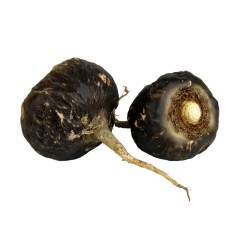
Black Maca Organic Seeds...
Price
€2.05
(SKU: VE 168)
Seeds Gallery EU,
5/
5
<!DOCTYPE html>
<html>
<head>
<meta http-equiv="Content-Type" content="text/html; charset=UTF-8" />
</head>
<body>
<h2><strong>Black Maca Organic Seeds (Lepidium meyenii) Aphrodisiac</strong></h2>
<h2><span style="color: #ff0000;"><strong>Price for Package of 20 seeds.<br /></strong></span></h2>
<div>Maca (Lepidium meyenii) is a hearty root vegetable grown in the high Andes of Bolivia and Peru. Cultivated since pre-Incan times, it is prized by indigenous peoples for its nutritional and medicinal properties along with its power as an aphrodisiac, energy enhancer and hormonal balancer.</div>
<div>Nutritional Profile:</div>
<div>A dietary staple for the indigenous peoples of the Andes, Maca (L. meyenii) is rich in nutrients, containing 31 different minerals, amino acids, antioxidants, alkaloids and sterols. Maca is an "adaptogen", a substance which brings the body to a heightened state of resistance to disease. Studies suggest that it has a balancing effect on the hypothalamus, which in turn balances other endocrine glands in the body.</div>
<div> </div>
<div>Clinical Research:</div>
<div>Maca (L. meyenii) root has flourished for thousands of years in the high Andes at altitudes up to 14,000 feet, in extreme climatic conditions where few other plants can survive a single season. Scientists suggest that Maca's remarkable endurance may help to explain its energizing and adaptogenic properties. Peruvian and Chinese researchers have conducted clinical tests on both humans and animals, verifying Maca's capacity to strengthen the libido and increase sperm count.
<div>
<table cellspacing="0" cellpadding="0" border="1">
<tbody>
<tr>
<td colspan="2" width="100%" valign="top">
<h3><span style="color: #008000;"><strong>Sowing Instructions</strong></span></h3>
</td>
</tr>
<tr>
<td valign="top" nowrap="nowrap">
<p><span style="color: #008000;"><strong>Propagation:</strong></span></p>
</td>
<td valign="top">
<p><span style="color: #008000;">Seeds</span></p>
</td>
</tr>
<tr>
<td valign="top" nowrap="nowrap">
<p><span style="color: #008000;"><strong>Pretreat:</strong></span></p>
</td>
<td valign="top">
<p><span style="color: #008000;">0</span></p>
</td>
</tr>
<tr>
<td valign="top" nowrap="nowrap">
<p><span style="color: #008000;"><strong>Stratification:</strong></span></p>
</td>
<td valign="top">
<p><span style="color: #008000;">0</span></p>
</td>
</tr>
<tr>
<td valign="top" nowrap="nowrap">
<p><span style="color: #008000;"><strong>Sowing Time:</strong></span></p>
</td>
<td valign="top">
<p><span style="color: #008000;">all year round </span></p>
</td>
</tr>
<tr>
<td valign="top" nowrap="nowrap">
<p><span style="color: #008000;"><strong>Sowing Depth:</strong></span></p>
</td>
<td valign="top">
<p><span style="color: #008000;">Just sprinkle on the surface of the substrate + gently press</span></p>
</td>
</tr>
<tr>
<td valign="top" nowrap="nowrap">
<p><span style="color: #008000;"><strong>Sowing Mix:</strong></span></p>
</td>
<td valign="top">
<p><span style="color: #008000;">Coir or sowing mix + sand or perlite</span></p>
</td>
</tr>
<tr>
<td valign="top" nowrap="nowrap">
<p><span style="color: #008000;"><strong>Germination temperature:</strong></span></p>
</td>
<td valign="top">
<p><span style="color: #008000;">20 ° C</span></p>
</td>
</tr>
<tr>
<td valign="top" nowrap="nowrap">
<p><span style="color: #008000;"><strong>Location:</strong></span></p>
</td>
<td valign="top">
<p><span style="color: #008000;">bright + keep constantly moist not wet</span></p>
</td>
</tr>
<tr>
<td valign="top" nowrap="nowrap">
<p><span style="color: #008000;"><strong>Germination Time:</strong></span></p>
</td>
<td valign="top">
<p><span style="color: #008000;">1-6 weeks</span></p>
</td>
</tr>
<tr>
<td valign="top" nowrap="nowrap">
<p><span style="color: #008000;"><strong>Watering:</strong></span></p>
</td>
<td valign="top">
<p><span style="color: #008000;">Water regularly during the growing season</span></p>
</td>
</tr>
<tr>
<td valign="top" nowrap="nowrap">
<p><span style="color: #008000;"><strong> </strong></span></p>
</td>
<td valign="top">
<p><br /><span style="color: #008000;"><em>Copyright © 2012 Seeds Gallery - Saatgut Galerie - Galerija semena. </em><em>All Rights Reserved.</em><em></em></span></p>
</td>
</tr>
</tbody>
</table>
</div>
</div>
</body>
</html>
VE 168 (20 S)





